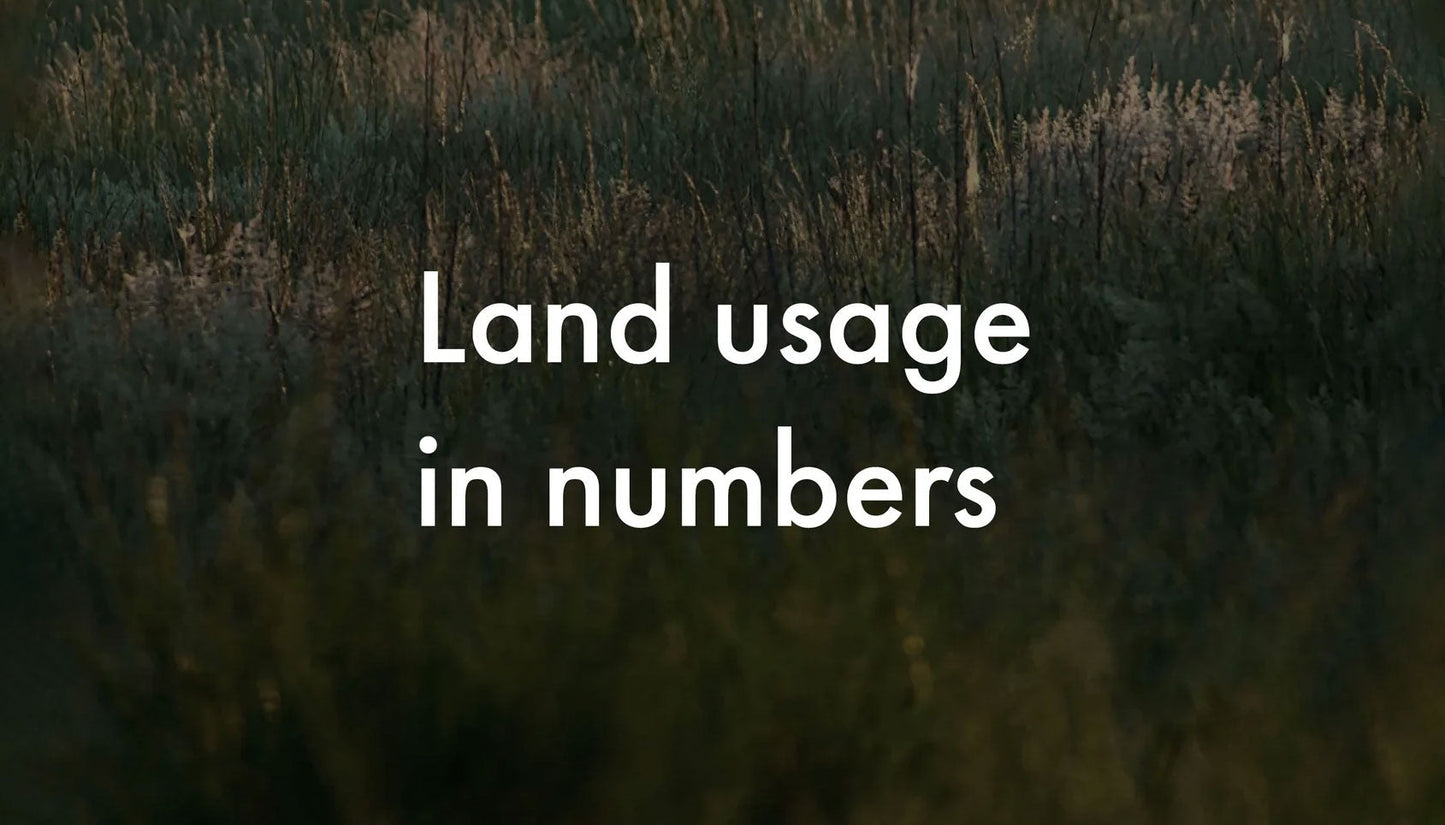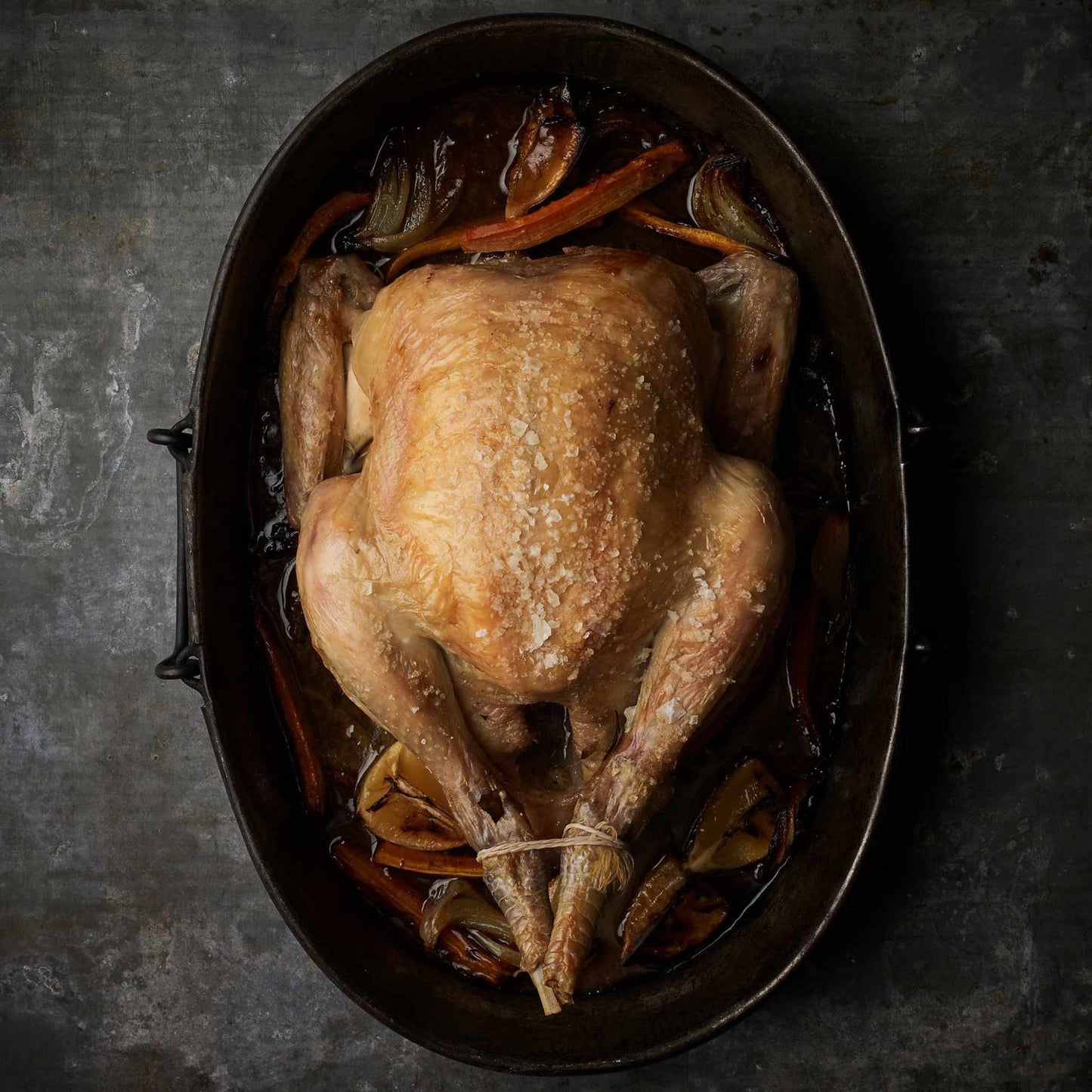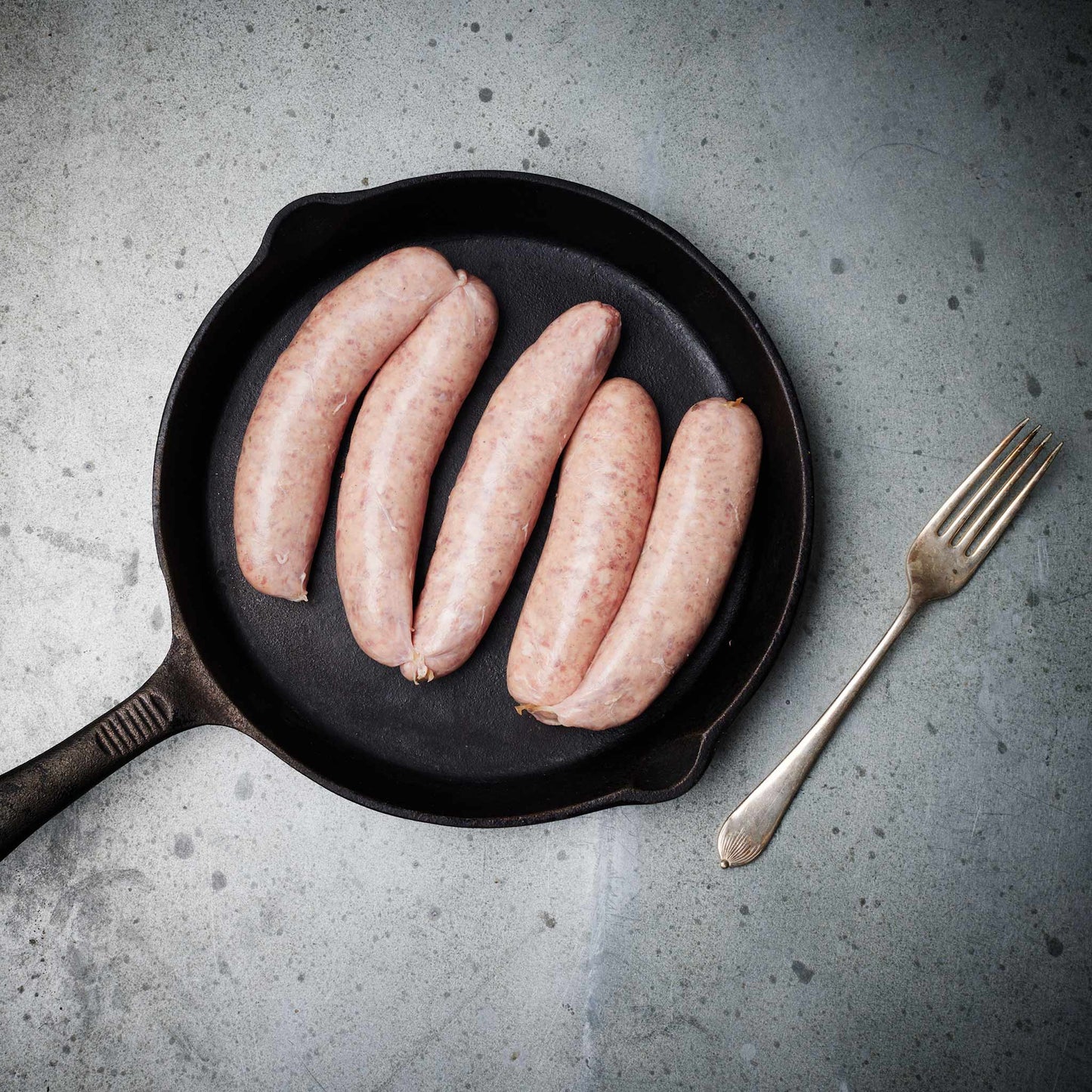We source our chicken from one farm in Leicestershire. The farm is Pasture for Life certified and rears truly free range, outdoor birds.

It's been suggested to us many times that instead of farming animals for food we should rewild the land to sequester carbon and eat a wholly or largely plant-based diet instead.
Let's consider the possible implications of this.
How much land is used for agriculture?

Rather a lot. The planet's surface is 71% salty water, leaving 29% land.
Habitable / non habitable land
Out of that 29% surface area of land, only 71% is habitable, the rest being glaciers (mostly Antarctica) and what is known as barren land meaning salt flats, deserts, exposed rock, beaches and dunes.
Agricultural land usage
Out of the habitable land, 37% is forest, 11% shrub, only 1% urban including settlements and infrastructure like roads, and the same volume is freshwater at roughly 1.5 million km square. This leaves a whopping 50% of all habitable land at 51 million km/square used for agriculture.
This actually represents 11% of the surface of the earth used for agriculture — still a lot.
Figures from here by Our World in Data.
Animal / Arable land usage
It's often said to us that animal agriculture uses way more land to produce way fewer calories than plant foods. This is true, so again, let's look at the figures and consider what 'uses' means.
Of all agricultural land, livestock farming uses 77% of it (this figure includes arable used to grow feed for animals as well as the grazing land itself), and some studies suggest that this huge land usage only provides 18% of global calories. On the surface, this sounds like a bad idea, but we need to dig deeper.
If we were to compare a different metric, such as complete proteins, and then include the bioavailability of these foods in the human body, we would see that calories are not a useful or applicable measurement in this case.
How much land can grow crops?
The agricultural area use is divided into three categories: arable land (28% of the global agricultural area), permanent crops (3%) and permanent meadows and pastures (69%) which account for the largest share of the world’s agricultural area.6
This permanent meadows and pastures is considered marginal land: land that is of little agricultural value because crops produced from the area would be worth less than any rent paid for access to the area. Although the term marginal is often used in a subjective sense for less-than-ideal lands, it is fundamentally an economic term.
Economics drive land usage
Looking at the chart below without the information above, it looks like growing meat for human consumption would be a very foolish thing to do.

But is it?
Let's remember that land usage is driven by economics. A farmer would be crazy to use 184.8 m square to produce 100 calories of mutton protein if that land can grow crops, so this does not happen. So, grazing animals graze on marginal land.
Grazing animals are not removing the availability of land for crops.
Marginal land is way less productive than prime arable.
This means bigger farms. In fact, farms that are sometimes bigger than countries! Anna Creek Farm in south Australia is bigger than Israel — which is staggering — but this is land that is not suitable for anything else. This way, it still provides valuable calories and nutrition for us.

In the UK, clearly the scales are smaller but the same principle holds: cattle and sheep are not using land that could grow higher value crops.
So we've established that due to the nature of, well, nature, animal agriculture uses way more land than arable but we need to consider what the implications of this use are for the land and where we can improve.
Typical arable farming — can it be improved?
Crops are generally grown in a mono-crop or mono-culture system. Monoculture is widely used both in industrial farming and in organic farming. It has allowed farmers to increase efficiency in planting, managing, and harvesting but it can also increase the risk of diseases or pest outbreaks.
The problem with this system is that it is in a constant battle with nature. The farmer looking after a single crop only wants that single crop to grow on his / her land; there is no advantage to allow other plants to compete for nutrients, sunlight or water and the only insects to be encouraged are ones required for pollination — certainly not the ones that want to eat the crops.
Many of the methods employed by this type of farming are aimed at reducing biodiversity in the field.

In parts of USA and Canada, for example, this system can extend over many hundreds of square miles with maybe only 2 species of plant.
Because monoculture farms only harbour a single species, these areas don’t support a diverse collection of animals or other plants. This throws the ecosystem out of balance and makes it susceptible to serious problems. For example, some of the insects living in monoculture farms may not have any predators at all. This allows their populations to grow out of control, which is then countered with the application of chemicals.
Monocultures tend to be chemically dependent on all manner of inputs, pesticides, rodenticides, weedkillers, fertilisers and so on, all throwing nature even more out of balance.
However, we can produce crops in a better system than this: a system that integrates animals and crops into a rotational pattern to restore soil fertility and change the stressors on the land by cyclical rotation that is suitable for the environment and natural habitat.
So, why isn't this done?
One of the main reasons is scale. On a huge arable farm, the farmer will be geared up to produce, harvest and sell just one crop. The machinery and technology is expensive so, to a typical 400 acre farm in the USA, the thought of transitioning every 4 years to beef production would be a logistical impossibility.
Maybe smaller, more diverse farms are the answer.
How do animals fit into natural grassland ecology?
We've written about grassland ecology in more detail here so to paraphrase, there is a mutualism between grasses and grazing animals. That is, each needs the other to thrive and survive.
Grass must be eaten down by ruminants to survive. Without grazing, grasses grow high, desiccate and oxidize. They slough off their roots and after a few years stop growing altogether. By grazing most of the plant leaves and moving on to new pastures, ruminants revitalise grasslands. Without grazing, the land dies.
Grass is not just what you see above ground. Perennial grasses put down deep roots during the growing season, and around the roots a universe of biological activity occurs. The roots exude sugars to attract the previously unconnected microbes and fungi underground. These organisms network themselves and begin to breakdown bedrock into minerals the plant's roots can absorb. The plant can signal for nutrients and water, or tell the underground miners it is under attack and to create substances to help the plant fight insects and diseases.
After a grazing animal eats its leaves, the plant lets most of its root system go dormant. Later it begins growing new roots to reestablish its nutrient and immune support system underground. Here is the magic: the old roots, made of carbon and water, serve as the foundation of new topsoil.
Carbon rich soil continues to generate biological activity underground. It forms a sponge that can absorb huge amounts of water from rainfall or flooding, which it slowly releases over time: drought tolerance and flood resilience.
This process is critical to carbon sequestration. Health grasslands take carbon from the atmosphere and place it safely underground.
Grasslands without ruminant herds moving from place to place are called deserts. The grass cannot survive. Herds that are left to roam and graze at will don't hack it.
Earlier we looked at how much of the earth's surface is natural grassland and it's rather a lot.
Rewilded vegan utopia.
Great, so we have these huge areas of the earth that can't grow crops and need to be grazed to support the ecosystems, so let's just rewild them, right?
Let's consider the implications of this in the UK.
We set aside areas of the country to let nature rewild and take over, except we need to create the initial conditions so we have to introduce grazing animals. To keep these numbers in check, we would also have to introduce apex predators, meaning animals such as bears and wolves.
So, if humans no longer eat grazing animals, how will they die?
In the wild, very few animals die from old age. This study suggests the figure is less than 5%. The truth is nature is brutal: animals die from starvation, disease, predation or more like a combination. Their deaths are, at best, being eaten alive and, at worst, some kind of long drawn out suffering.
When humans kill animals for food, we generally do it as quickly and cleanly as possible. There is absolutely no reason to not do what we can to prevent fear and treat death with respect. This means that humans can be the most humane omnivores on earth, however we agree with full conviction that factory farming is not humane.
What happens if we stop eating animals?
If we stop eating meats and animal based foods we need to replace those 18% of calories.
However, calories are probably not the best metric to use in this debate as protein is the least caloric macronutrient and animal foods are very rich in protein. If we compare amino acids in plant based foods and take into account the bioavailability of these proteins, we see how this 18% figure is way too low in real terms.
If we need to replace these missing nutrients, where does the extra land come from? The truth is it will result in more intensive arable production, making more ingredients to be highly processed to meet these demands. If this is done without animals in the system it means more chemical inputs, quicker soil destruction with far fewer opportunities to sequester carbon. The stresses on the land we do farm would be much higher.
Rewilded farming and regenerative agriculture.
We can rewild the landscape, farm in harmony with nature, build biodiversity and sequester carbon, give semi-wild animals a quick and painless death and avoid the need for wolves and bears to cull the numbers and keep nature in balance. This style of farming seeks wherever possible to increase biodiversity and encourage as much other life on this land, making the system less brittle to changes. Humans take the place within this system as the apex predators and can help keep nature in balance.
Holistic grazing
One of the methods for doing this is holistic planned or mob grazing. It is a management system that seeks to mimic the conditions of grazing animals on grassland.
In a natural system, grazing animals herd and move differently to domesticated ones. They tend to stay in a large group and move constantly due to fear of predation, which has a different effect on the land and is very beneficial to the soil ecology, and hence builds biodiversity from the ground up. This intensive action over a short period of a moving herd pulls carbon into the soil, locking it away out of the atmosphere as life thrives.
Farmers can replicate these methods by herding and moving their animals to mimic these conditions, building the same diversity and soil as in nature.
We eat a balanced amount of arable crops which can be fertilised with animal based manure, lessening the needs for so many chemical inputs.
To summarise, we can restore our place in the ecosystem and realise we are a part of nature not separate from it by using a holistic (not a reductionist) approach to feeding ourselves.
Nature will nourish us in return.



